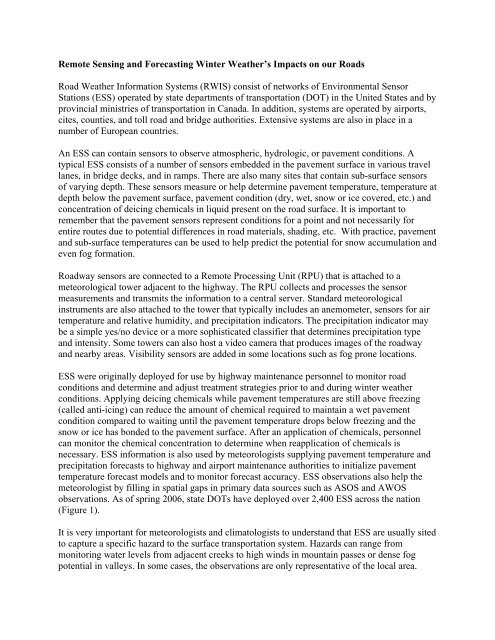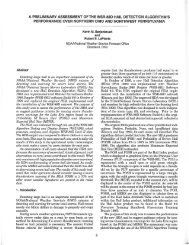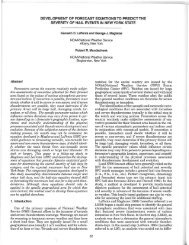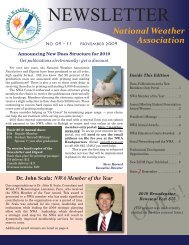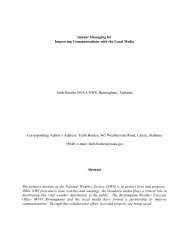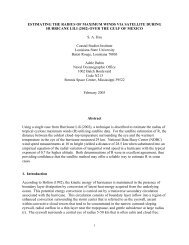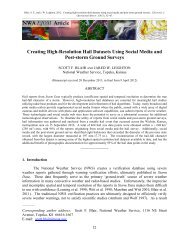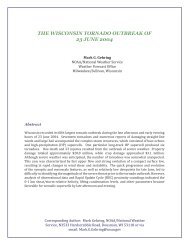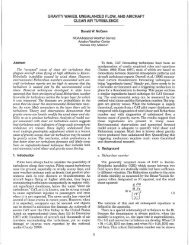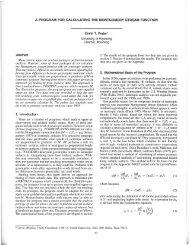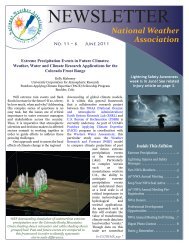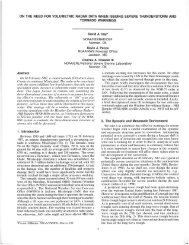Remote Sensing and Winter Weather - National Weather Association
Remote Sensing and Winter Weather - National Weather Association
Remote Sensing and Winter Weather - National Weather Association
Create successful ePaper yourself
Turn your PDF publications into a flip-book with our unique Google optimized e-Paper software.
<strong>Remote</strong> <strong>Sensing</strong> <strong>and</strong> Forecasting <strong>Winter</strong> <strong>Weather</strong>’s Impacts on our Roads<br />
Road <strong>Weather</strong> Information Systems (RWIS) consist of networks of Environmental Sensor<br />
Stations (ESS) operated by state departments of transportation (DOT) in the United States <strong>and</strong> by<br />
provincial ministries of transportation in Canada. In addition, systems are operated by airports,<br />
cites, counties, <strong>and</strong> toll road <strong>and</strong> bridge authorities. Extensive systems are also in place in a<br />
number of European countries.<br />
An ESS can contain sensors to observe atmospheric, hydrologic, or pavement conditions. A<br />
typical ESS consists of a number of sensors embedded in the pavement surface in various travel<br />
lanes, in bridge decks, <strong>and</strong> in ramps. There are also many sites that contain sub-surface sensors<br />
of varying depth. These sensors measure or help determine pavement temperature, temperature at<br />
depth below the pavement surface, pavement condition (dry, wet, snow or ice covered, etc.) <strong>and</strong><br />
concentration of deicing chemicals in liquid present on the road surface. It is important to<br />
remember that the pavement sensors represent conditions for a point <strong>and</strong> not necessarily for<br />
entire routes due to potential differences in road materials, shading, etc. With practice, pavement<br />
<strong>and</strong> sub-surface temperatures can be used to help predict the potential for snow accumulation <strong>and</strong><br />
even fog formation.<br />
Roadway sensors are connected to a <strong>Remote</strong> Processing Unit (RPU) that is attached to a<br />
meteorological tower adjacent to the highway. The RPU collects <strong>and</strong> processes the sensor<br />
measurements <strong>and</strong> transmits the information to a central server. St<strong>and</strong>ard meteorological<br />
instruments are also attached to the tower that typically includes an anemometer, sensors for air<br />
temperature <strong>and</strong> relative humidity, <strong>and</strong> precipitation indicators. The precipitation indicator may<br />
be a simple yes/no device or a more sophisticated classifier that determines precipitation type<br />
<strong>and</strong> intensity. Some towers can also host a video camera that produces images of the roadway<br />
<strong>and</strong> nearby areas. Visibility sensors are added in some locations such as fog prone locations.<br />
ESS were originally deployed for use by highway maintenance personnel to monitor road<br />
conditions <strong>and</strong> determine <strong>and</strong> adjust treatment strategies prior to <strong>and</strong> during winter weather<br />
conditions. Applying deicing chemicals while pavement temperatures are still above freezing<br />
(called anti-icing) can reduce the amount of chemical required to maintain a wet pavement<br />
condition compared to waiting until the pavement temperature drops below freezing <strong>and</strong> the<br />
snow or ice has bonded to the pavement surface. After an application of chemicals, personnel<br />
can monitor the chemical concentration to determine when reapplication of chemicals is<br />
necessary. ESS information is also used by meteorologists supplying pavement temperature <strong>and</strong><br />
precipitation forecasts to highway <strong>and</strong> airport maintenance authorities to initialize pavement<br />
temperature forecast models <strong>and</strong> to monitor forecast accuracy. ESS observations also help the<br />
meteorologist by filling in spatial gaps in primary data sources such as ASOS <strong>and</strong> AWOS<br />
observations. As of spring 2006, state DOTs have deployed over 2,400 ESS across the nation<br />
(Figure 1).<br />
It is very important for meteorologists <strong>and</strong> climatologists to underst<strong>and</strong> that ESS are usually sited<br />
to capture a specific hazard to the surface transportation system. Hazards can range from<br />
monitoring water levels from adjacent creeks to high winds in mountain passes or dense fog<br />
potential in valleys. In some cases, the observations are only representative of the local area.
Users of these data must be able to obtain <strong>and</strong> underst<strong>and</strong> station metadata to properly use ESS<br />
observations in general weather forecasting.<br />
There are three main sources of RWIS/ESS data for the general meteorological community. A<br />
complete listing of 39 state DOT ESS web sites is maintained by the Federal Highway<br />
Administration’s (FHWA) Road <strong>Weather</strong> Management Program (www.fhwa.dot.gov/weather).<br />
The ESS web site listing can be found at:<br />
http://www.ops.fhwa.dot.gov/weather/best_practices/1024x768/transform2.asp?xslname=SRCw<br />
ebsites.xslt&xmlname=SRCwebsites.xml.<br />
A second source of ESS data is the Meteorological Assimilation Data Ingest System (MADIS).<br />
Developed by the <strong>National</strong> Oceanic <strong>and</strong> Atmospheric Administration’s (NOAA) Earth System<br />
Research Laboratory, MADIS is a data management system that collects <strong>and</strong> disseminates<br />
observations from a variety of public <strong>and</strong> private mesonets. MADIS, found at<br />
http://madis.noaa.gov/, provides weather observations from more than 20,000 locations in North<br />
America including ESS, profilers, aviation observations <strong>and</strong> marine data. MADIS also provides<br />
some automated quality checking. As of fall 2006 MADIS was collecting ESS data from 25<br />
different DOTs (in blue, Figure 2). NOAA has recently begun the transition of the MADIS<br />
functionality from its current, research state into NOAA operations within the <strong>National</strong> <strong>Weather</strong><br />
Service’s (NWS) Telecommunications Operations Center (TOC) that will support many users’<br />
needs.<br />
The third source of ESS data is a new FHWA initiative called Clarus. Clarus, from the Latin<br />
word for “Clear”, is a new data management system designed to meet the goal of collecting all<br />
state transportation agency ESS from across the nation. In addition, Clarus will make use of<br />
advanced quality checking algorithms for both atmospheric <strong>and</strong> pavement observations. Finally,<br />
Clarus will contain an extensive metadata library describing many aspects of ESS sites <strong>and</strong><br />
sensors.<br />
Information about Clarus can be found at http://www.clarusinitiative.org/. A proof of concept<br />
demonstration of the system capabilities will be concluded in December 2006. A regional<br />
demonstration will take place during much of 2007 <strong>and</strong> into 2008. FHWA <strong>and</strong> NOAA are<br />
coordinating the merging of the Clarus functionality with MADIS capabilities within the NWS’<br />
TOC <strong>and</strong> contained within a new NOAA operational system called the <strong>National</strong> Surface <strong>Weather</strong><br />
Observing System (NSWOS).<br />
For specific information on FHWA’s Road <strong>Weather</strong> Management Program or Clarus, contact<br />
Paul Pisano at Paul.Pisano@dot.gov. For information on NOAA’s Surface <strong>Weather</strong> Program or<br />
NSWOS, contact Jim O’Sullivan at jim.osullivan@noaa.gov.<br />
The committee extends their gratitude to Andy Stern, a consultant to FHWA, as well as Paul<br />
Pisano <strong>and</strong> Jim O’Sullivan for their contributions to this article. This <strong>and</strong> other remote sensing<br />
education <strong>and</strong> training articles can also be found on the NWA <strong>Remote</strong> <strong>Sensing</strong> Committee web<br />
site http://www.nwas.org/committees/rs/train.html.<br />
David Trask, NWA <strong>Remote</strong> <strong>Sensing</strong> Committee
Figure 1. ESS owned by State DOT<br />
Figure 2. State DOTs providing ESS to NOAA/MADIS


